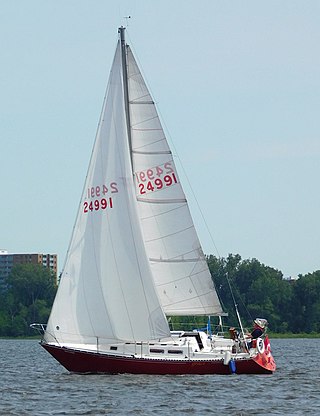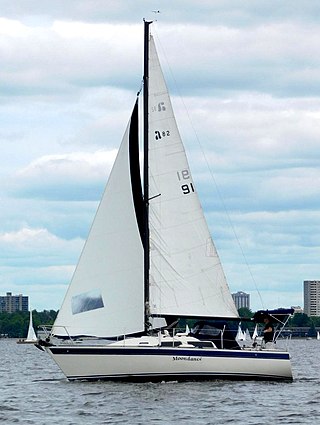Related Research Articles

The Express 27 is an American trailerable sailboat that was designed by Carl Schumacher as a racer and first built in 1982.

The Tanzer 25 is a Canadian trailerable sailboat, that was designed by the French company of Joubert-Nivelt and first built in 1986. The design is out of production.
The US Yachts US 25 is an American trailerable sailboat, that was designed by Gary Mull and first built in 1981. The design is out of production.

The C&C 29 is a Canadian sailboat, that was designed by Cuthbertson & Cassian as an International Offshore Rule Half Ton class racer-cruiser and first built in 1977.

The Aloha 27 is a series of Canadian sailboats, that were designed by American yacht designer Robert Perry and first built in 1979 under the designation Aloha 26.
The Orion 27-2, also called the Orion 27 Mk II, is an American sailboat that was designed by Henry Mohrschladt as a cruiser and first built in 1981.
The Island Packet 27 is an American sailboat that was designed by Robert K. Johnson as a cruiser and first built in 1984.
The Morgan 32 is an American sailboat that was designed by Ted Brewer and Jack Corey and first built in 1980.
The Watkins 32 is an American sailboat that was designed by William H. Tripp Jr as a cruiser and first built in 1982.
The Watkins 23 is an American trailerable sailboat that was designed by Johannes "Jopie" Helsen, modified by Watkins Yachts and first built in 1973.
The Watkins 17, also referred to as the W17, is an American trailerable sailboat that was designed by the Watkins brothers and first built in 1975.
The Watkins 27, also known as the W27, is an American sailboat that was designed by naval architect Walter Scott and first built in 1977.
The Watkins 36, also known as the W36 and W36AC, is an American sailboat that was designed by William H. Tripp Jr and the Watkins brothers, first built in 1981.
The Watkins 36C, also known as the W36C, is an American sailboat that was designed by William H. Tripp Jr and the Watkins brothers. It was first built in 1981.
The Watkins 29, also known as the W29, is an American sailboat that was designed by Walter Scott in conjunction with the Watkins brothers and first built in 1984.
The Watkins 25, also known as the W25 and marketed as the Seawolf 25 from 1986, is an American trailerable sailboat that was designed by the Watkins Design Team and first built in 1983.
The Com-Pac 25 is an American trailerable sailboat that was designed as a cruiser.
The Cape Dory 33 is an American sailboat that was designed by Carl Alberg as cruiser and first built in 1980.
The Irwin 27 is an American sailboat that was designed by Ted Irwin as a cruiser and first built in 1967.
The Com-Pac 23 is an American trailerable sailboat that was designed by Clark Mills as a pocket cruiser and first built in 1978. The boat has undergone design changes over time resulting in a series of improved models.
References
- 1 2 3 4 McArthur, Bruce (2019). "Watkins 27P sailboat". sailboatdata.com. Archived from the original on 2 October 2019. Retrieved 4 November 2019.
- ↑ McArthur, Bruce (2019). "Walter Scott". sailboatdata.com. Archived from the original on 7 August 2019. Retrieved 4 November 2019.
- 1 2 3 4 5 Watkins Owners Association (20 October 2006). "Watkins W27/W27P". watkinsowners.com. Archived from the original on 13 April 2019. Retrieved 4 November 2019.
- 1 2 3 4 5 6 Sea Time Tech, LLC (2022). "Watkins 27P". sailboat.guide. Archived from the original on 11 April 2022. Retrieved 11 April 2022.
- 1 2 3 McArthur, Bruce (2019). "Watkins 27 sailboat". sailboatdata.com. Archived from the original on 7 August 2019. Retrieved 2 November 2019.
- ↑ McArthur, Bruce (2019). "Watkins Yachts 1973 - 1989". sailboatdata.com. Archived from the original on 2 October 2019. Retrieved 4 November 2019.
- 1 2 3 4 5 6 Watkins Owners Association (3 May 2008). "History of Watkins Yachts". watkinsowners.com. Archived from the original on 14 March 2019. Retrieved 4 November 2019.
- ↑ McArthur, Bruce (2022). "Watkins Owners". sailboatdata.com. Archived from the original on 22 March 2022. Retrieved 22 March 2022.